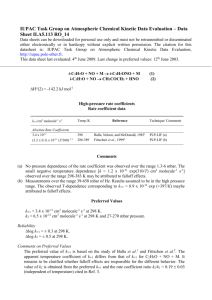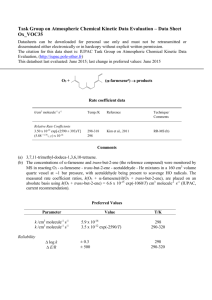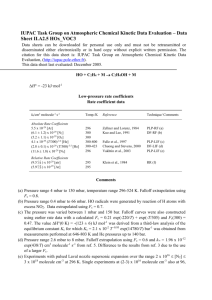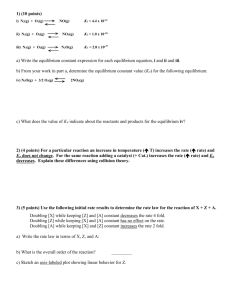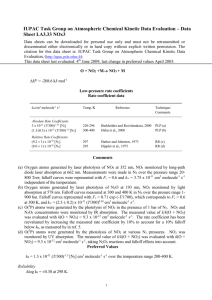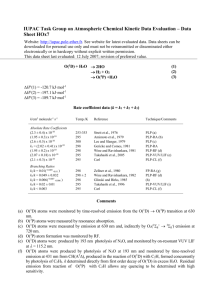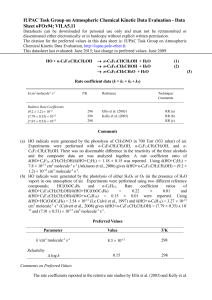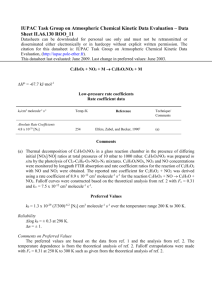Data Sheet II.A2.7 HOx_VOC5 - IUPAC Task Group on Atmospheric
advertisement
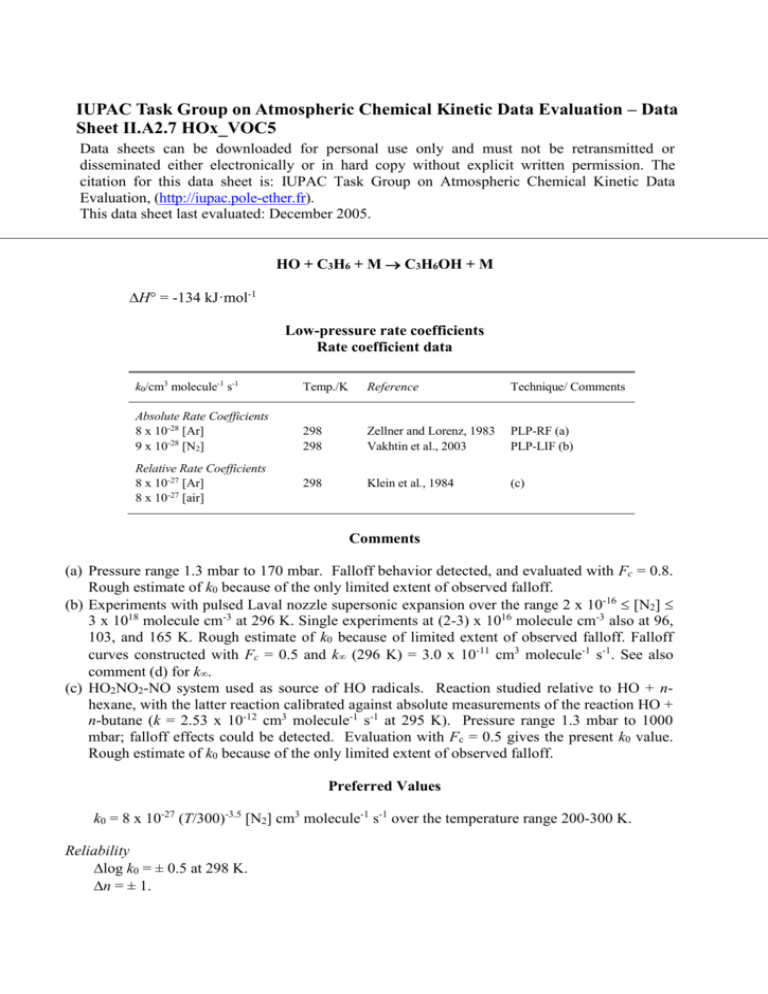
IUPAC Task Group on Atmospheric Chemical Kinetic Data Evaluation – Data Sheet II.A2.7 HOx_VOC5 Data sheets can be downloaded for personal use only and must not be retransmitted or disseminated either electronically or in hard copy without explicit written permission. The citation for this data sheet is: IUPAC Task Group on Atmospheric Chemical Kinetic Data Evaluation, (http://iupac.pole-ether.fr). This data sheet last evaluated: December 2005. HO + C3H6 + M C3H6OH + M H° = -134 kJ·mol-1 Low-pressure rate coefficients Rate coefficient data k0/cm3 molecule-1 s-1 Temp./K Reference Technique/ Comments Absolute Rate Coefficients 8 x 10-28 [Ar] 9 x 10-28 [N2] 298 298 Zellner and Lorenz, 1983 Vakhtin et al., 2003 PLP-RF (a) PLP-LIF (b) 298 Klein et al., 1984 (c) Relative Rate Coefficients 8 x 10-27 [Ar] 8 x 10-27 [air] Comments (a) Pressure range 1.3 mbar to 170 mbar. Falloff behavior detected, and evaluated with Fc = 0.8. Rough estimate of k0 because of the only limited extent of observed falloff. (b) Experiments with pulsed Laval nozzle supersonic expansion over the range 2 x 10-16 [N2] 3 x 1018 molecule cm-3 at 296 K. Single experiments at (2-3) x 1016 molecule cm-3 also at 96, 103, and 165 K. Rough estimate of k0 because of limited extent of observed falloff. Falloff curves constructed with Fc = 0.5 and k (296 K) = 3.0 x 10-11 cm3 molecule-1 s-1. See also comment (d) for k. (c) HO2NO2-NO system used as source of HO radicals. Reaction studied relative to HO + nhexane, with the latter reaction calibrated against absolute measurements of the reaction HO + n-butane (k = 2.53 x 10-12 cm3 molecule-1 s-1 at 295 K). Pressure range 1.3 mbar to 1000 mbar; falloff effects could be detected. Evaluation with Fc = 0.5 gives the present k0 value. Rough estimate of k0 because of the only limited extent of observed falloff. Preferred Values k0 = 8 x 10-27 (T/300)-3.5 [N2] cm3 molecule-1 s-1 over the temperature range 200-300 K. Reliability log k0 = ± 0.5 at 298 K. n = ± 1. Comments on Preferred Values The uncertainty of the extrapolated k0 is large, because the reaction is close to the highpressure limit at pressures. The preferred values follow the falloff extrapolation from ref. 2 which shows the smallest scatter. Falloff extrapolations are made using Fc = 0.5 at 300 K. The temperature coefficient of k0 is estimated by analogy to the reaction HO + C2H4 + M C2H4OH + M. High-pressure rate coefficients Rate coefficient data k/cm3 molecule-1 s-1 Temp./K Reference Technique/ Comments Absolute Rate Coefficients (3.0 ± 0.5) x 10-11 (2.95 0.1) x 10-11(T/300)-1.06 298 95-296 Zellner and Lorenz, 1984 Vakhtin et al., 2003 PLP-RF (a) PLP-LIF (b) Relative Rate Coefficients (3.0 ± 0.2) x 10-11 (8.1 1.8) x 10-11 295 103 Klein et al., 1984 Vakhtin et al., 2001 (c) (d) Comments (a) See comment (a) for k0. (b) See comment (b) for k0. (c) See comment (c) for k0. (d) Pulsed Laval nozzle supersonic expansion of nitrogen with admixed reactants. OH generated by photolysis of H2O2 or reaction of O(1D) with n-butane after photolysis of N2O. [N2] = 2.1 x 1016 molecule cm-3. Reaction observed very close to the high pressure limit. Preferred Values k = 2.9 x 10-11 cm3 molecule-1 s-1 at 298 K and 1 bar of air. k = 3.0 x 10-11 (T/300)-1 cm3 molecule-1 s-1 over the range 200-300 K. Reliability log k = ± 0.1 over the temperature range 200 K to 300 K. n = ± 1. Comments on Preferred Values The preferred values are based on Zellner and Lorenz (1984), Klein et al. (1984), Vakhtin et al. (2003), Nielsen et al. (1990) and Tully and Goldsmith (1985). There is an uncertainty about the extent of falloff at temperatures above 300 K and there is the possibility of a small activation barrier, such as observed in the reaction HO + C2H2 + M C2H2OH + M. The preferred temperature dependence is derived by combining the results from Zellner and Lorenz (1984), Klein et al. (1984) and Vakhtin et al. (2003), confirming the suggestions from Atkinson (1994) and Tsang (1991). Fc = 0.5 serves for estimating the extent of falloff. The following text-line combines the preferred values for the high and low pressure limiting rate coefficients to generate a single, cut-and-paste expression for calculation of k: =((8e-27*(T/300)^-3.5)*M*(3.0e-11*(T/300)^-1))/((8e-27*(T/300)^-3.5)*M+(3.0e-11*(T/300)^1))*10^(log10(0.5)/(1+(log10((8e-27*(T/300)^-3.5)*M/(3.0e-11*(T/300)^-1))/(0.75-1.27*log10(0.5)))^2)) The molecular density, M = 7.2431021P(bar)/T(K) References Atkinson, R.: J. Phys. Chem. Ref. Data, Monograph 2, 82, 1994. Klein, Th., Barnes, I., Becker, K. H., Fink, E. H. and Zabel, F.: J. Phys. Chem. 88, 5020, 1984. Nielsen, O. J., Jørgensen, O., Donlon, M., Sidebottom, H. W., O'Farrell, D. J. and Treacy, J.: Chem. Phys. Lett 168, 319, 1990. Tsang, W.: J. Phys. Chem. Ref. Data 20, 221, 1991. Tully, F. P. and Goldsmith, J. E. M.: Chem. Phys. Lett. 116, 345, 1985. Vakhtin, A. B., Lee, S., Heard, D. E., Smith, I. W. M. and Leone, S. R.: J. Phys. Chem. A 105, 7889, 2001. Vakhtin, A. B., Murphy, J. E. and Leone, S. R.: J. Phys. Chem. A, 107, 10055, 2003. Zellner, R. and Lorenz, K.: J. Phys. Chem. 88, 984, 1984.
